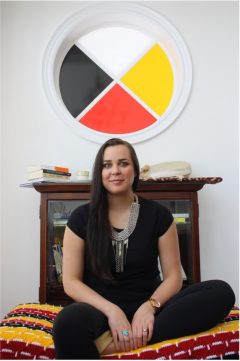The Pathfinders Series Feature: Julie Williams
THE PATHFINDERS: RFNG’s Julie Williams on how self-government is about living a life authentic to First Nations’ values
| The Rebuilding First Nations Governance Project is chatting with movers and shakers advancing First Nations’ inherent right to self-government in Canada. Part Q&A and part F.A.Q., The Pathfinders features members of our project and others talking about why self-government matters to them and why it should matter to you. |

Julie Williams (pictured) from Chippewas of Rama First Nation is helping First Nations communities in Canada connect to their pasts, theirtraditional languages, and their vibrant futures. In the process, she’s also helping First Nations reconnect with themselves.
As a researcher at the Rebuilding First Nations Governance Project, Julie investigates ways in which First Nations can think about their traditional values and forms of government. The insightful policy expert develops strategies for First Nations to revitalize their traditional languagesand use them to describe how they once governed their people before Europeans arrived. Her work guides First Nations across Turtle Island examining their values and pasts for insight on building a better present.
In this edition of The Pathfinders: How connecting to the past can help present-day First Nations, how language revitalization and strong self-government support each other, why present-day First Nations need to know their traditional values, why the Five Pillars of Effective Governance are a useful tool, how Julie’s spirituality and identity motivate her to support self-government.
Why is it important to you that First Nations people think about the way they governed in the past in the present day?
I think in order to move forward, we need to know where we come from. I spent a lot of my own life wondering who I was. Where did I come from? What are my values? My original values?
I kind of think about it like putting on an old, really good pairof worked-in jeans. When it’s yours, it just fits so well. It’s like a second skin. To move forward, we have to understand where we’re coming from and find that appropriate match.
The effects of colonization and the Indian Act interrupted how comfortable our own self-government actually feels on our skin. We have to think back to those original values, systems and the way things were organized and interpret themfor a modern context. We can shed what doesn’t fit very well and create something new and old that fits just right.
You work with this idea of The Five Pillars of Effective Governance developed by the Centre for First Nations Governance. Do you think you could explain it in really simple terms? What are each of those five pillars?
When we think about what our societies were like before contact and when we think about where our societies are now, there are five pillars that help us to understand different aspects that come together to create a community.
We look at the historical understanding of communities by using the pillars. Then we also look at communities now, and we try to help them bridge the gap. If they had the opportunity to have uninterrupted continuity of their society, what would those five pillars look like? When we think about society, it can be really overwhelming, but the five pillars sort of give us that entryway into understanding different aspects.
So, we have (1) The People. They’re the ones that drive what happens in a community. There’s (2) The Land. Everything that we really understand about who we are and our connection to the world is related to the land. I also think of The Land Pillar as all that we are in constant relation with. There’s also (3) Laws and Jurisdiction, which is about the values and norms that govern those relationships. There’s (4) Governing Systems—you might think about that as a chief and council or clan system. And then the final one is (5) Resources, where we’re really talking about human capacity.
All of those five things make up a really effective, functioning, healthycommunity where you can have democracy and consensus building, move towards a vision and hold your values.
Why is it important that First Nations people are thinking about how to govern themselves in their own terms?
I think it’s important to own who we are, to believe in the beauty of who we are, and to move forward in a way that is authentic to us. In the same way that I was talking about how we don’t want to put on someone else’s jeans—it’s a weird metaphor, but I’m gonna go with it—we want to be able to show up and be authentic.
The things that we bring into the world—how we treat each other and how we live in relation to the land and honor our traditional teachings—those things are really difficult because of the interruptions that have occurred over the course of history and contact.
We have so much beauty. We have somuch wisdom. We have so much intelligence. We are just such fantastic spirits and human beings. And the world deserves to know that beauty. For ourselves, we deserve to own that beauty and live a life that is authentic to our values. The current system that is imposed doesn’t allow that to happen.When we think about creating our own or rebuilding our governance and rebuilding our societies, it’s about that vision of being authentic to ourselves and knowing our beauty and knowing what we have to offer the world.

I understand that part of the way you think about past governance is through language. Why do First Nations communities need language in the present day to think about how they governed themselves in the past?
You can use your language to interact with the world around you—it’s like an entirely different encyclopedia that gives you information on how to relate to it. Language gives you information about what an entity, or being, or plant or medicine is.
Language revitalization is really helpful when we think about how we want to re-establish our values. The language helps us to see the world through that encyclopedia. Everything is labeled with all the knowledge and wisdom of our ancestors. That’s all in the language.
But we also have to work with where we’re at right now. And, you know, many of us, myself included, we don’t have fluency in our traditional language. And the English language doesn’t always translate well.
It’s important when we’re speaking with each other and our community to understand how language can be relational to us. We just want to be really conscious about how we talk about things like resources, for example. In English, when we talk about resources, we think about extraction. We think about oil and gas and mining and things that come from the earth. But really, when we think about those things in an Indigenous context, they’re not resources, right? We relate to them in a spiritual way. Those entities—some of them have their own rights. We have to honour those rights. We honour that which sustains us.
So in order to try and overcome this association that we have with the word “resources,” we’re trying to think about talking about it in terms of “that which sustains us,” which is more akin to how our traditional languages might describe it.
It’s important to think about how we’re relating to each other through a language that doesn’t necessarily hold our worldview the way that our traditional languages did and still do. It’s about trying to use the tools that we have to convey the spirit of our ancestral wisdom and knowledge.
Why should the average First Nations person care about self-government?
That’s a big question. I hesitate to speak for anyone else. I think for me, it’s about authenticity. It’s about doing what’s right for us—knowing and living our teachings and being able to do that in the world. But it’s also about what that means for the health of our communities and our health as individuals.
If somebody is constantly telling you what you should be doing and how to do it, it limits your ability to live your life purpose. In my community—your life purpose is given to you by Creator.
There’s a conflict there—when you can’t exercise your own life-purpose. You can feel it calling you in your spirit.
That conflict is wrapped up in the stewardship of the world. For example, there’s so many answers to climate change in the beauty of First Nations governance. It’s not just about us and our life-purpose. It’s about that duty we have to all living beings. And our traditional approaches brought forward in a modern context are answers to the kind of healing that the world needs.
Why does your work matter to you?
It is wrapped up in that purpose I have that Creator gave to me. Where I come from, I’m not a human being with a spirit. I’m a spirit having a physical experience. And that spirit was sent here to do something very specific in service and purpose. This is what I feel called to do. It’s almost like I don’t have a choice. It just has to happen.
I want to help other people. I don’t want to do that for them but to support them in their mission, whatever their mission is. This is the path I feel called to support.
Learn more about The Five Pillars of Effective Governance |
|---|
| RFNG’s lead partner, The Centre for First Nations Governance, created the Five Pillars of Effective Governance through its decades-long work with First Nations citizens, leaders and Elders. Here’s how the Centre describes them: “The pillars blend the traditional values of our respective nations with the modern realities of self-governance. The Centre uses the principles behind these five pillars to develop and deliver tools and services to help transform our nations. We believe that all First Nations can benefit by enacting some or all of these principles no matter where they are on their path to self-governance.” You can learn more about this self-government tool by visiting the Centre’s website. |
Interviews for The Pathfinders have been edited for length and clarity. Written by Ben Sylvestre with editorial oversight from Julie Williams. Feature image courtesy of Jennifer Saxton. The Rebuilding First Nations Governance Project is supported in part by funding from the Social Sciences and Humanities Research Council.
| More questions? Send us an email! |